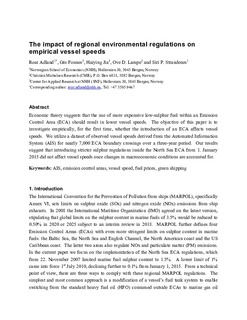| dc.contributor.author | Ådland, Roar Os | |
| dc.contributor.author | Fonnes, Gro | |
| dc.contributor.author | Jia, Haiying | |
| dc.contributor.author | Daae Lampe, Ove | |
| dc.contributor.author | Strandenes, Siri Pettersen | |
| dc.date.accessioned | 2017-11-13T09:23:01Z | |
| dc.date.available | 2017-11-13T09:23:01Z | |
| dc.date.created | 2017-05-15T12:32:56Z | |
| dc.date.issued | 2017 | |
| dc.identifier.citation | Transportation Research Part D: Transport and Environment. 2017, 53 37-49. | nb_NO |
| dc.identifier.issn | 1361-9209 | |
| dc.identifier.uri | http://hdl.handle.net/11250/2465706 | |
| dc.description.abstract | Economic theory suggests that the use of more expensive low-sulphur fuel within an Emission Control Area (ECA) should result in lower vessel speeds. The objective of this paper is to investigate empirically, for the first time, whether the introduction of an ECA affects vessel speeds. We utilize a dataset of observed vessel speeds derived from the Automated Information System (AIS) for nearly 7000 ECA boundary crossings over a three-year period. Our results suggest that introducing stricter sulphur regulations inside the North Sea ECA from 1. January 2015 did not affect vessel speeds once changes in macroeconomic conditions are accounted for. | nb_NO |
| dc.language.iso | eng | nb_NO |
| dc.title | The impact of regional environmental regulations on empirical vessel speeds | nb_NO |
| dc.type | Journal article | nb_NO |
| dc.type | Peer reviewed | nb_NO |
| dc.description.version | acceptedVersion | nb_NO |
| dc.source.pagenumber | 37-49 | nb_NO |
| dc.source.volume | 53 | nb_NO |
| dc.source.journal | Transportation Research Part D: Transport and Environment | nb_NO |
| dc.identifier.doi | 10.1016/j.trd.2017.03.018 | |
| dc.identifier.cristin | 1470239 | |
| dc.relation.project | Norges forskningsråd: 239104 | nb_NO |
| cristin.unitcode | 191,30,0,0 | |
| cristin.unitname | Institutt for samfunnsøkonomi | |
| cristin.ispublished | true | |
| cristin.fulltext | original | |
| cristin.qualitycode | 2 | |
